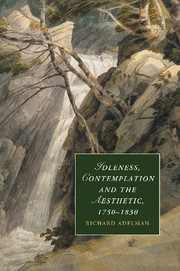Book contents
- Frontmatter
- Contents
- Acknowledgements
- List of abbreviations
- Introduction
- 1 The division of labour
- 2 Utilitarian education and aesthetic education
- 3 Cowper, Coleridge and Wollstonecraft
- 4 Coleridge's Pantisocracy, Biographia and Church and State
- Conclusion
- Epilogue: Wordsworth and Kingsley
- Notes
- Bibliography
- Index
- CAMBRIDGE STUDIES IN ROMANTICISM
4 - Coleridge's Pantisocracy, Biographia and Church and State
Published online by Cambridge University Press: 01 June 2011
- Frontmatter
- Contents
- Acknowledgements
- List of abbreviations
- Introduction
- 1 The division of labour
- 2 Utilitarian education and aesthetic education
- 3 Cowper, Coleridge and Wollstonecraft
- 4 Coleridge's Pantisocracy, Biographia and Church and State
- Conclusion
- Epilogue: Wordsworth and Kingsley
- Notes
- Bibliography
- Index
- CAMBRIDGE STUDIES IN ROMANTICISM
Summary
While Cowper's brown study stands over the string of accounts we have just explored, foreshadowing their rhetoric and setting down the terms in which their fears are to be articulated, to consider Coleridge's thought more generally, as we are to do now, is to encounter a system that seems repeatedly to address, discuss and concern itself with the parameters of idle thought in a whole range of different ways. Thus Cowper's role as an anchor or as a mooring point for Coleridge's ruminations in ‘Frost at Midnight’ is not one Coleridge turns to very often. Rather, in the years leading up to ‘Effusion xxxv’ and ‘Frost at Midnight’, in the various tales and explanations that make up the Biographia Literaria, and in the carefully thought-out delineations of Church and State, Coleridge can be seen to be developing and staging a conception of poetic capability that departs significantly from Cowper's terminology. The model of poetic activity that emerges from these discussions may be apt to be aligned with the concerns opened up in ‘Effusion xxxv’ and ‘Frost at Midnight’, but is also one that leads to a range of concerns markedly distinct from these poems, and that is deployed in a range of radically different contexts, with widely differing objectives.
- Type
- Chapter
- Information
- Idleness, Contemplation and the Aesthetic, 1750–1830 , pp. 102 - 132Publisher: Cambridge University PressPrint publication year: 2011

